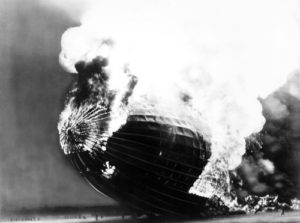The "Hindenburg Omen" is a complex stock market indicator that's predicted every stock market crash since 1987. And the Hindenburg Omen just signaled again last week (May 4).
The indicator is named after the Hindenburg disaster, when the ill-fated German dirigible caught fire and crashed in New Jersey in 1937. The Hindenburg Omen is a series of technical stock market indicators that have aligned just before historical stock market crashes going back to 1987.

Now that the Hindenburg Omen is signaling again, traders are wondering if another stock market crash is coming.
Here's the exact definition of the Hindenburg Omen and why investors should always be prepared for a potential stock market crash...
What Causes a Hindenburg Omen?
The Hindenburg Omen occurs when these four events happen on the same trading day. According to Investopedia, the first two events are:
- At least 2.2% of all stocks on the New York Stock Exchange must hit their 52-week high.
- At least 2.2% of all stocks on the New York Stock Exchange must hit their 52-week low.
CNBC adds that two more events must also happen on the same trading day:
- The S&P 500 must be trading above its 50-day moving average.
- The "McClellan Oscillator" must be negative for the day. The McClellan Oscillator is a complicated technical indicator used by financial analysts, and a negative reading essentially means money is leaving the market.
In other words, some stocks are being bid up to new highs as other stocks are bid down to new lows. At the same time, traders are pulling money out of the market even as the index is trading above its recent average.
Don't Miss: Our Essential Guide to Buying Gold and Silver
While these metrics are specific, they are an indication that traders are very uncertain about the future direction of the stock market. A high amount of uncertainty among traders could signal a market correction is coming.
But not everyone buys the power of the Hindenburg Omen. While the indicator has triggered before every stock market crash since 1987, the market hasn't crashed every time the Hindenburg Omen hits. In fact, The Wall Street Journal says a significant downturn has followed the indicator only about 25% of the time.
Jim Miekka, the mathematician who developed Hindenburg Omen, has argued it's only meant to warn investors.
"It's sort of like a funnel cloud," Miekka told the WSJ in 2010. "It doesn't mean it's going to crash, but it's a high probability. You don't get a tornado without a funnel cloud."
Investors are right to be skeptical of an overly specific predictor of market events. It's possible to retroactively connect unrelated data to specific historical events, or it's even possible Miekka's indicator is simply a coincidence.
But we can't deny that the Hindenburg Omen has shown up before every stock market crash since 1987. And this isn't the only reason investors should be prepared in the event of a stock market crash this year...
Why Investors Should Prepare for a Market Crash in 2017
Stocks are hitting historically high valuations, and that's also happened before past stock market crashes.
The stock market is still riding a nine-year bull run dating back to March 2009, and stocks continue to surge even higher. In what's now dubbed the "Trump Rally," the Dow has surged 15% since Election Day, all while smashing through record highs, including breaking through the 20,000 and 21,000 levels for the first time.
This has been great for investors, but it has some wondering if stock prices have gotten too high.
And there's reason to think stocks are overvalued, a sign that stocks could correct back to their real value, which could start a market crash. While we talked about the Hindenburg Omen above, a simpler measure of the stock market shows stocks are at historically high valuations.
The Shiller P/E ratio is a basic measure of the overall value of the stock market. It measures the ratio between stock prices and earnings, but accounts for past performance. That's made it one of the most famous measures of market value we have. And according to its creator, Robert Shiller, exceptionally high valuations are a sign of danger.
Right now, the Shiller P/E ratio is sitting at 29.8, which is 77.4% higher than its historical average. For comparison, the Shiller P/E ratio hit a high of 27.4 before the 2008 stock market crash.
High stock valuations don't necessarily mean a stock market crash will happen, but they can be a red flag. If stocks are pushed to soaring highs through artificial means, like low interest rates, instead of through sustained economic performance, then a sudden market sell-off could send stocks tumbling.
That's why we think every investor should be considering the possibility of a stock market crash. But that doesn't mean panicking or selling all of your stocks. We've put together a guide on how to protect your money, and profit, during a stock market crash...
Follow Money Morning on Twitter @moneymorning, Facebook, and LinkedIn.
[mmpazkzone name="end-story-hostage" network="9794" site="307044" id="138536" type="4"]


